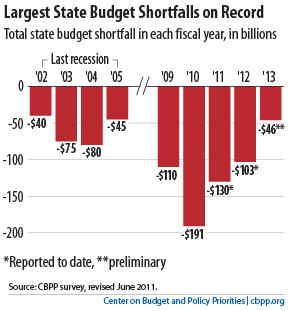BEYOND THE NUMBERS
States have seen stronger-than-expected revenue growth in the last few months, the clearest sign yet that state budgets are recovering from the depths of the recession. But as our new update on state budget shortfalls makes clear, states are just beginning to climb out of a very deep hole.

States continue to face a major fiscal challenge. Some 42 states and the District of Columbia have closed or are working to close $103 billion in shortfalls for the coming fiscal year (2012). These gaps are all the more daunting because states’ options for addressing them are fewer and more difficult. Temporary aid to states under the federal 2009 Recovery Act was enormously helpful in allowing states to avert some of the most harmful potential budget cuts in 2009, 2010, and 2011. But that aid will largely be gone by the end of June, when fiscal 2011 comes to a close.
State finances are recovering, but that recovery will be slow. While shortfall projections remain high, they have declined somewhat in recent months as states’ revenue outlook has improved. Nevertheless, states are just beginning to emerge from a deep fiscal hole, and their recovery will be slow. The economy remains weak, unemployment is still high, and state fiscal recovery tends to lag behind recovery in the broader economy.
Despite these signs of improvement, states will continue to face shortfalls in future years that remain very large by historical standards. Some 24 states have projected shortfalls totaling $46 billion for 2013 (the fiscal year that begins 13 months from now). As more states prepare estimates, this total will likely grow.
These findings imply that while the size of the problem has changed, the solution has not. Even with an improved fiscal outlook, states will still need to take a balanced approach to closing their shortfalls.
As we’ve explained in past posts, states like Arizona and Washington State, which this year have relied solely on cuts to close their large gaps, have made severe cuts to critical services like education and health care. States that have yet to finalize their budgets would do far better to follow the example of Connecticut, which raised significant additional revenue to limit the need for these kinds of cuts.
Given the depth of the recession and the weakness of the economic recovery, it will take some time before states return to fiscal health. But a balanced approach can help states to minimize the damage that they inflict on their economy and their most vulnerable residents.
